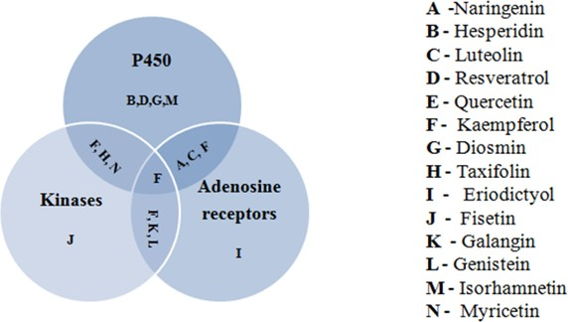In silico predictions of NADPH oxidase binding properties of selected flavonoids - Protective role in arsenic induced neurotoxicity
Abstract
The study was an attempt to provide evidence for the effect of selected flavonoids on NADPH oxidase (NOX), which is a key enzyme in the generation of oxidative stress. For this study, a set of flavonoids were selected and screened for their molecular properties like physicochemical descriptions, oral bioavailability, Blood-Brain Barrier (BBB) penetration and P-glycoprotein (Pgp) substrate property using Molinspiration online tool, Swiss ADME and Swiss Target Prediction websites. Based on the molecular properties, three flavonoids (Naringenin, hesperidin and diosmin) were narrowed down for further molecular docking studies as they were found to be Pgp substrates. The protein targets were duly selected as they are the subunits of the NOX subtype, which was commonly expressed in the brain and they are key elements of NOX activation. Molecular docking studies were carried out with Autodock vina software to enumerate the binding energies of the flavonoid molecules with the selected protein targets. The three flavonoids naringenin, hesperidin and diosmin, have shown good binding energies for the selected targets compared to apocynin, a well-known NOX inhibitor. The molecular docking results revealed that hesperidin had shown the highest bonding energies, followed by diosmin and naringenin. These flavonoids naringenin, hesperidin and diosmin, might be the better inhibitors of NOX and might usefully help in combating arsenic induced neurotoxicity. These in silico findings need further confirmation by in vitro and in vivo studies.
Full text article
References
S J S Flora. Arsenic-induced oxidative stress and its reversibility. Free Radical Biology and Medicine, 51(2):257–281, 2011.
Y Kumagai and J Pi. Molecular basis for arsenic induced alteration in nitric oxide production and oxidative stress: implication of endothelial dysfunction. Toxicology and applied pharmacology, 198(3):450–457, 2004.
B M Babior. NADPH Oxidase. Current opinion in immunology, 16(1):42–47, 2004.
Y Qian, K J Liu, Y Chen, D C Flynn, V Castranova, and X Shi. Cdc42 regulates arsenic-induced NADPH oxidase activation and cell migration through actin filament reorganization. Journal of Biological Chemistry, 280(5):3875–3884, 2005.
A Lemarie, E Bourdonnay, C Morzadec, O Fardel, and L Vernhet. Inorganic arsenic activates reduced NADPH oxidase in human primary macrophages through a Rho kinase/p38 kinase pathway. The Journal of Immunology, 180(9):6010–6017, 2008.
A N Panche, A D Diwan, and S R Chandra. Flavonoids: an overview. Journal of nutritional science, 5:e47, 2016.
G C Terstappen and A Reggiani. In silico research in drug discovery. Trends in pharmacological sciences, 22(1):23–26, 2001.
K Y Samhita Vinay and Sowmya Vinay. Assessing the efficacy of NOX enzyme inhibitors as potential treatments for ischemic stroke in silico. Journal of Emerging Investigators, 2:1–7, 2020.
M Yamamoto, A Suzuki, H Jokura, N Yamamoto, and T Hase. Glucosyl hesperidin prevents endothelial dysfunction and oxidative stress in spontaneously hypertensive rats. Nutrition, 24(5):470–476, 2008.
W Li, C Wang, J Peng, J Liang, Y Jin, and Q Liu. Naringenin inhibits TNF-α induced oxidative stress and inflammatory response in HUVECs via Nox4/NF-kB and PI3K/Akt pathways. Current Pharmaceutical Biotechnology, 15(12):1173–1182.
W Yu, J Wu, F Cai, J Xiang, W Zha, and D Fan. Curcumin alleviates diabetic cardiomyopathy in experimental diabetic rats. PloS one, 7(12):52013–52013, 2012.
V Karuppagounder, S Arumugam, R A Thandavarayan, V Pitchaimani, R Sreedhar, and R Afrin. Naringenin ameliorates daunorubicin induced nephrotoxicity by mitigating AT1R, ERK1/2-NFkB p65 mediated inflammation. International immunopharmacology, 28(1):154–159, 2015.
L Xiao, L Liu, X Guo, S Zhang, J Wang, and F Zhou. Quercetin attenuates high fat diet induced atherosclerosis in apolipoprotein E knockout mice: A critical role of NADPH oxidase. Food and Chemical Toxicology, 105:22– 33, 2017.
Authors

This work is licensed under a Creative Commons Attribution-NonCommercial-NoDerivatives 4.0 International License.





